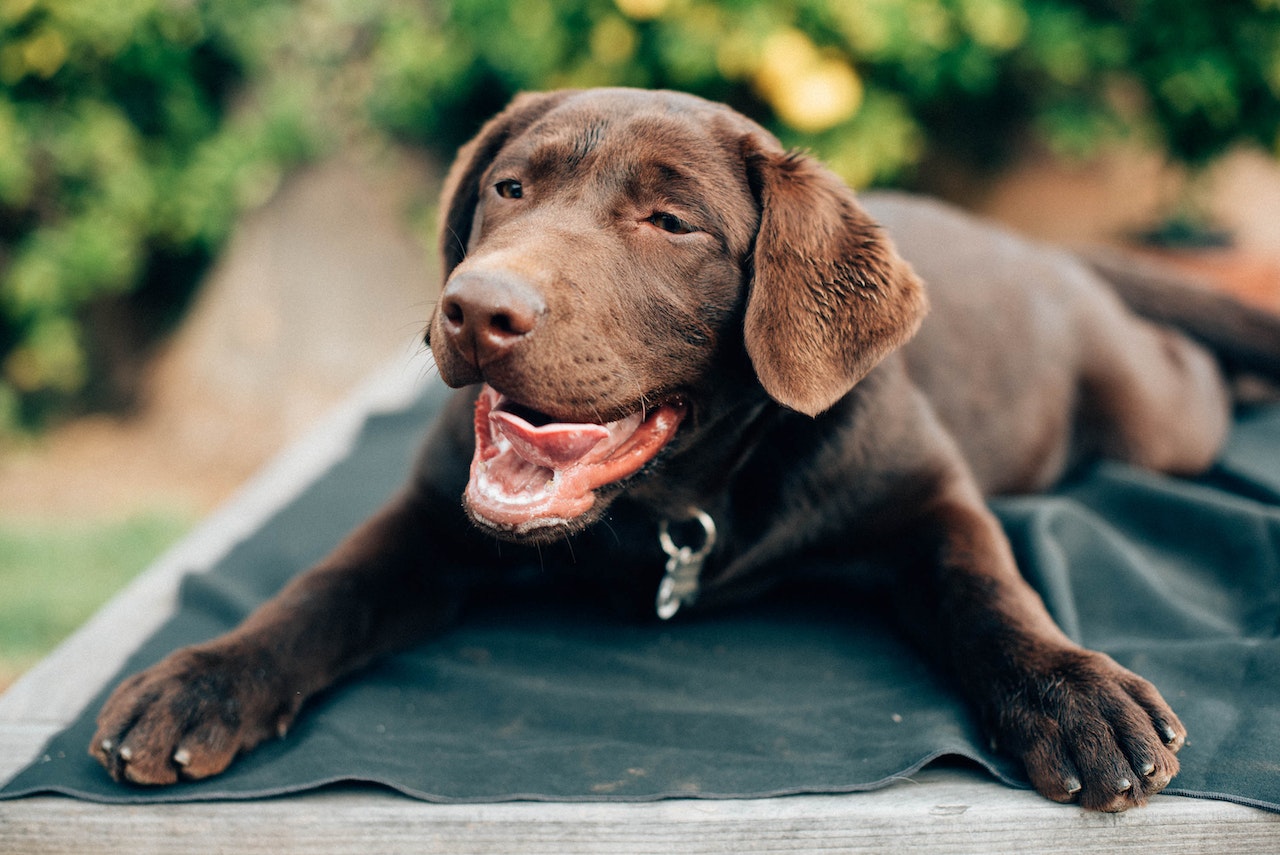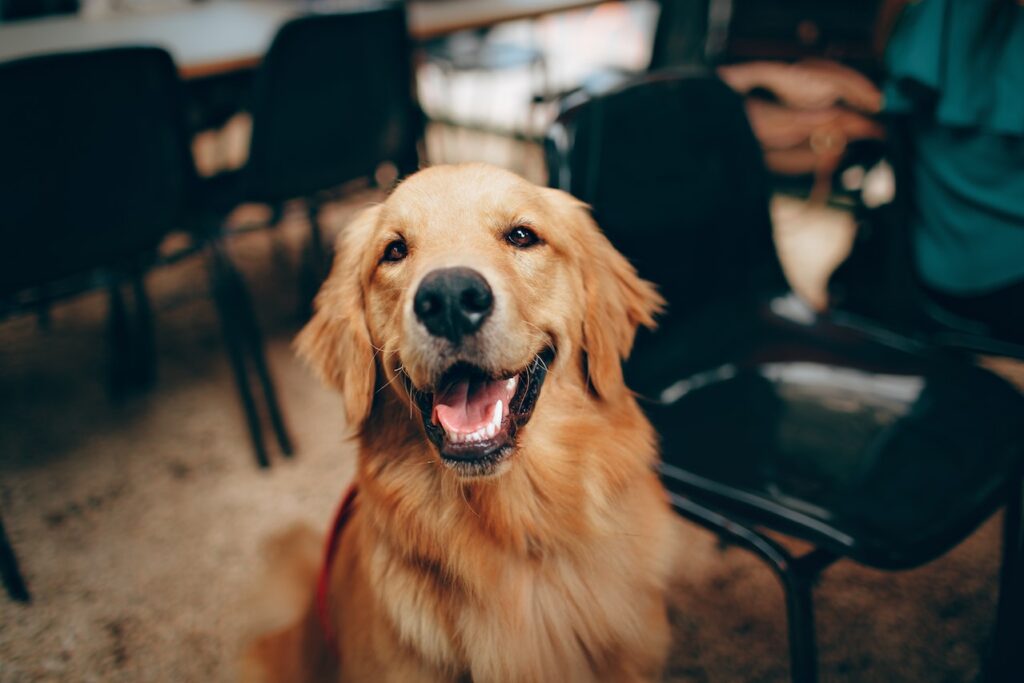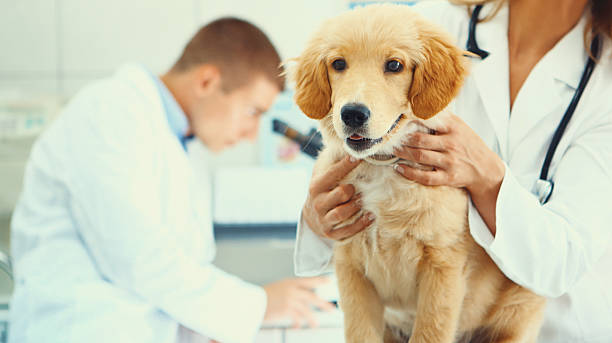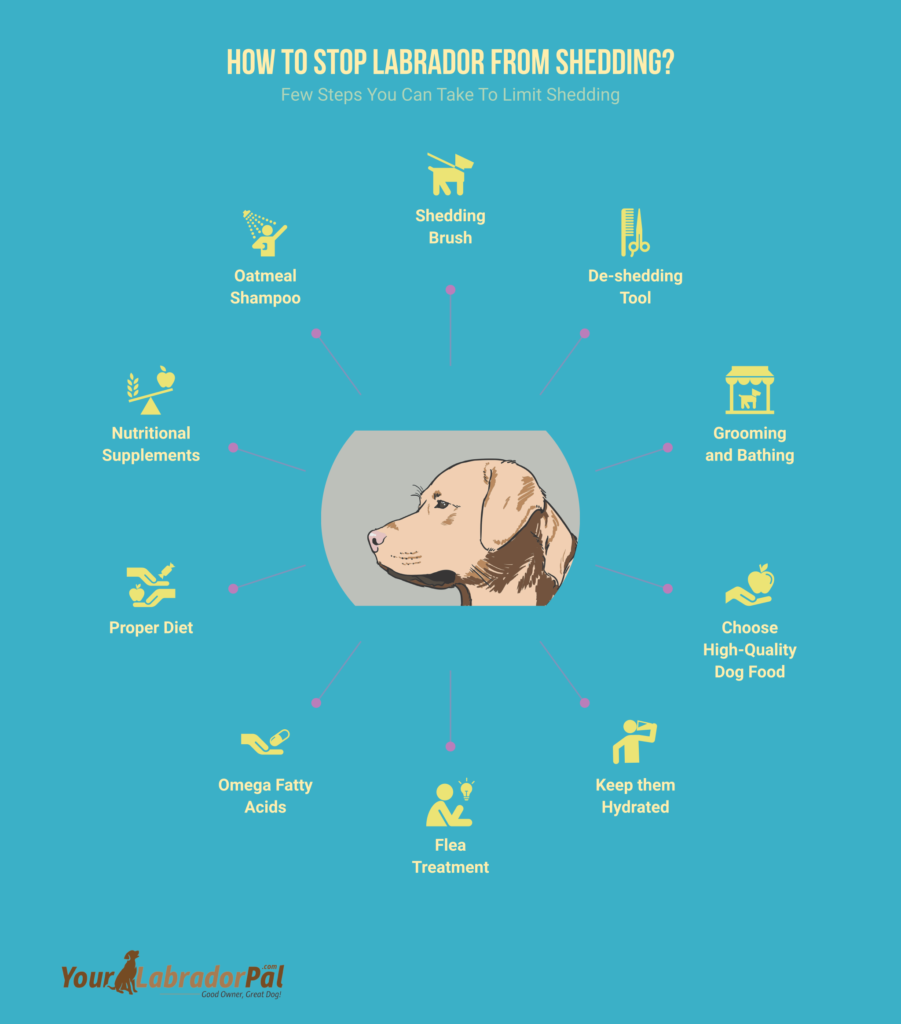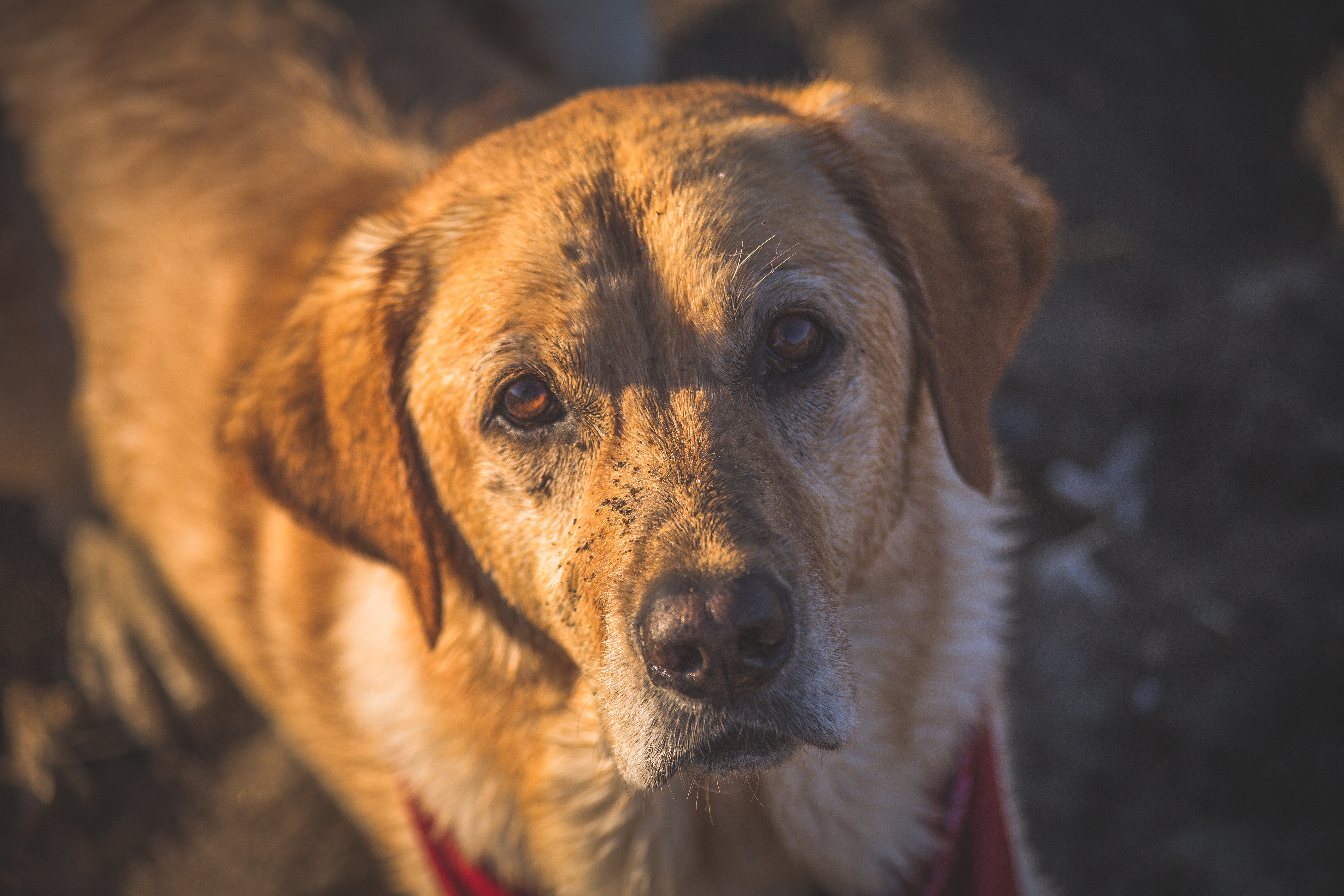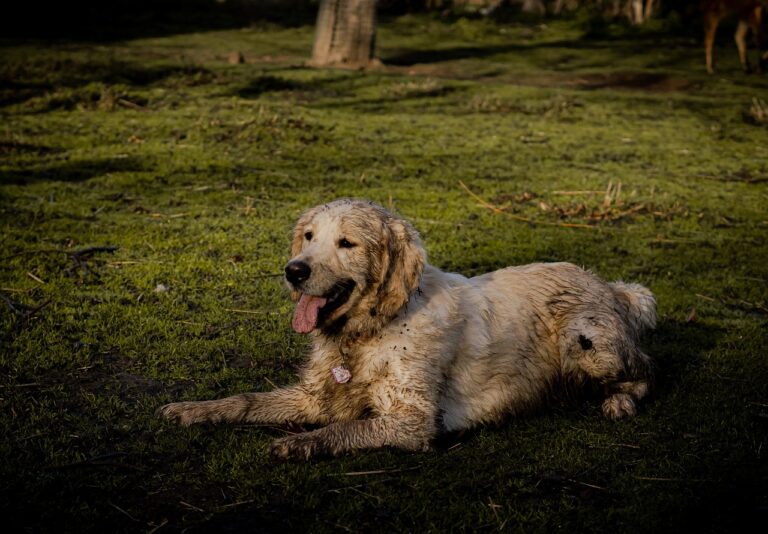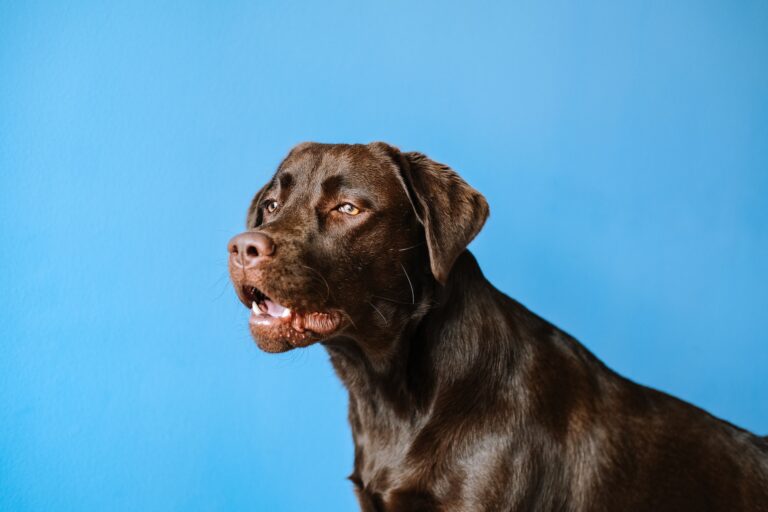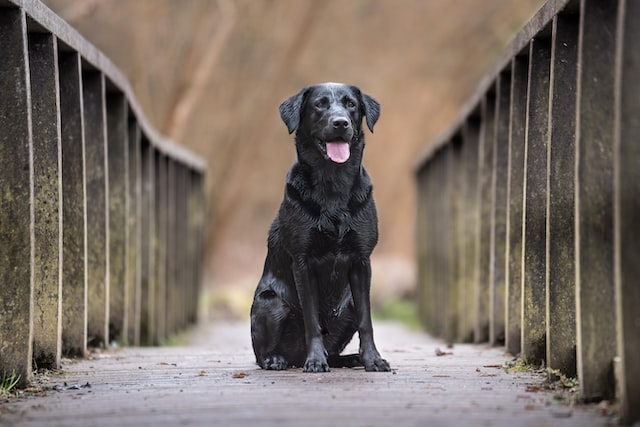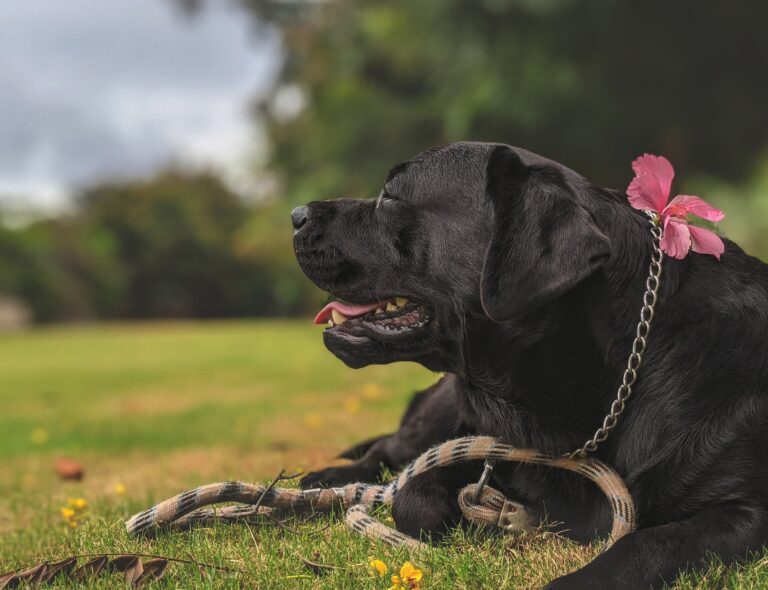How to Stop Labrador from Shedding?
Do you want to know how to stop Labrador from shedding? Perhaps you own a beautiful Labrador that sheds fur everywhere. Or you are tired of constantly cleaning up after your furry friend. Well, many dog owners face the same problem: excessive shedding.
But don’t worry; we’ve got you covered. In this article, we will share some tips and tricks on stopping Labrador from shedding. From grooming techniques to diet changes, we’ll explore various methods to help reduce shedding and keep your home fur-free. So, let’s get started on making your life a little less hairy.
Understanding the Labrador Retriever Coat
Labradors consist of a thick double coat, an outer coat that is soft and water resistant, plus an insulating undercoat. The outer coat comprises coarse guard hairs that protect the dog’s skin from water, dirt, and other elements. On the other hand, the undercoat is made up of soft and thick hairs that keep the dog warm and regulate body temperature. The undercoat is responsible for most of the Labrador shedding.
Why Do Labradors Shed?
Labradors are one of the most popular dog breeds in the world. They are known for their friendly demeanor, lovable personalities, and unbridled energy. But as much as we love them, it’s hard to ignore that they shed a lot.
It can be frustrating to clean up after your furry friend constantly, but there are several reasons why Labradors shed that you should know about. Understanding these reasons can help you manage the shedding and make life with your Labrador Retriever easier.
🌠Natural Process
Labrador shedding is a completely natural process that happens to all dogs. Labradors, in particular, are known for their thick double coats that keep them warm in cold weather. In the spring, they shed their thick winter coat to grow thinner coats for the summer. Changes in day length and temperature trigger this process. However, Labradors can shed all year round, especially if they live indoors without seasonal change. So, while shedding is natural, it can become a nuisance if not managed properly.
🌠Seasonal Changes
As mentioned, seasonal changes can play a role in shedding. Labradors start growing thicker coats in the fall to prepare for the winter. This new coat will help them stay warm during the colder months. In the spring, they shed their winter coat to grow thinner coats for the summer. This new coat will help them stay cool during the warmer months. Therefore, you should expect more shedding during the spring and fall seasons.
🌠Diet
Your dog’s diet also plays a significant role in its shedding. If your Labrador Retriever isn’t getting enough nutrients, their coat may not be healthy, and it may start shedding more. Feeding your dog a high-quality diet rich in vitamins and minerals will help them maintain healthy skin and coats. Omega-3 fatty acids also play a key role in promoting healthy skin and coat. Consider adding supplements containing omega-3s to your dog’s diet.
🌠Genetics
Genetics can also play a role in Labrador Retriever shedding. Some Labradors may have a genetic predisposition to shedding more than others. If both parents were heavy shedders, their offspring would likely be a heavy shedder. However, genetics is only one factor, and it can be managed with proper grooming and care.
🌠Stress
Like humans, dogs can experience stress, and it can manifest in different ways. One of the ways it can show up in Labradors is through shedding. However, this type of shedding may not be consistent, and it won’t be easy to identify that stress is the problem. But if you notice that your dog has been acting differently or is going through a stressful situation like moving to a new house, introducing new pets, or separation anxiety, some shedding may occur. Therefore, creating a comfortable environment for your dog is essential.
🌠Age
Labradors will inevitably shed more as they age. Older dogs’ skin becomes less elastic, making it more difficult for them to retain hair. An inadequate diet and lack of exercise can also increase shedding in aging dogs. However, regular grooming, ensuring that your pet gets quality dog’s food, and enough exercise can help reduce shedding even in older dogs.
🌠Grooming
Proper grooming can go a long way in managing shedding in Labradors. The breed’s thick and waterproof double coat entails brushing at least once every week. Proper brushing and ear cleaning maintain good hygiene, improve the quality of the dog hair and prevent matting. Matting can be painful and uncomfortable for your dog and can cause further shedding if not handled on time. Regular grooming sessions also allow you to monitor your dog’s skin to detect any signs of parasites or skin infections.
🌠Fleas and Ticks
Flea bites and tick infestations can cause excessive scratching, leading to more shedding. As a pet owner, it is essential to protect your pet from fleas and ticks by using flea and tick preventives from recognized brands available in the market. If your dog has fleas or ticks, bathe him with a mild shampoo and consult your veterinarian for further advice on how to get rid of them.
🌠Environment
Labradors naturally shed all year round, but they shed more during the spring and fall as they adapt to seasonal changes. The shift in temperature affects their hormones, which leads to excessive dog hair loss. Since they have thick coats, these shed hair are more noticeable. However, environmental factors like humidity or allergens can also trigger shedding. Therefore, pet owners need to monitor their dog’s living environment and provide them with a comfortable temperature and air circulation that’s adequate for their breed.
🌠Hormones
Unsurprisingly, hormones play a vital role in why Labradors shed so much. Just like humans, dogs have hormones that control hair growth and shedding. When an animal develops from a puppy into an adult dog, it goes through a hormonal change that initiates fur growth, and in the process, the old hair is shed to make way for new growth. Also, hormone changes cause the seasonal shedding of coats during Spring and Autumn.
🌠Coat Type
Please note that not all Labradors are the same. Some have a double-layered coat, while others have a single-layered coat. Double-coated Labradors have two layers, one that keeps them warm during winter and the second that keeps them cool in warmer months. The undercoat is fluffier, softer, and sheds more often, allowing for better air circulation during hotter months. On the other hand, single-coated Labradors don’t retain hair as much as their double-coated counterparts.
🌠Seasonal Allergies
Like humans, dogs can also get seasonal allergies that trigger excessive shedding. It can happen when allergens like pollen, dust, or molds come in contact with their skin or are inhaled. Their immune system goes on overdrive when this happens, and much hair is shed. Seasonal allergies can be a hassle and a regular occurrence in your Labrador’s life, especially if it spends lots of time outdoors. If you suspect your pet suffers from seasonal allergies, take it to the veterinarian for further diagnosis and advice on managing them.
🌠Health Issues
Did you know that excessive shedding can indicate underlying health problems? That’s right, and excessive hair loss could indicate anything from fleas to allergies to parasites. So if you’re concerned about your Lab’s constant shedding, take them to the vet.
These are some of the most common reasons why Labradors shed so much. If you suspect something else might be causing your pet’s excessive shedding, check it with a veterinarian.
Health Problems Causing Excessive Shedding
Here are some common health problems that can cause excessive shedding in Labrador.
1: Skin Conditions
Excessive shedding can be a symptom of various skin conditions, such as allergies and dermatitis. These conditions can cause your pet’s skin to become dry and itchy, leading to compulsive scratching and excessive shedding. Dogs can also develop hot spots, areas of raw, inflamed skin that can become infected if not treated. If your pet’s skin is red, flaky, or irritated, you should take them to the vet for a check-up.
2: Bacterial Infections
Bacterial skin infections are common in dogs and cats and can cause excessive shedding. These infections are usually caused by Staph bacteria, which can live on your pet’s skin without causing any problems. However, when your pet’s immune system is compromised, these bacteria can multiply and cause skin infections. Symptoms of a bacterial skin infection include redness, swelling, and discharge. Your vet may prescribe antibiotics or medicated shampoos to treat the infection.
3: Fungal Infections
Fungal infections are another common cause of excessive shedding in pets. Ringworm is a fungal infection that can cause dog hair loss and scaly patches on your pet’s skin. Other fungal infections that can cause excessive shedding include yeast infections and histoplasmosis. If you notice any signs of a fungal infection, such as bald patches, redness, or flaky skin, take your pet to the vet for a diagnosis and treatment.
4: Parasites
Parasites, such as fleas and ticks, can cause excessive shedding in pets. These parasites can irritate your pet’s skin, causing them to scratch and bite, ultimately leading to hair loss. Fleas commonly cause excessive shedding in cats, while ticks can cause hair loss in dogs. Check your pet regularly for fleas and ticks, and discuss the best way to prevent and treat these parasites with your vet.
5: Hormonal Imbalances
Hormonal imbalances can also cause excessive shedding in pets. Hypothyroidism, for example, is when the thyroid gland does not produce enough thyroid hormone, leading to skin problems and hair loss. Cushing’s disease, caused by an overproduction of cortisol, can also cause excessive shedding. If you notice that your pet is shedding excessively and exhibiting other symptoms, such as weight gain or loss, increased thirst, urination, or lethargy, take them to the vet for an evaluation.
6: Liver Conditions
A diseased liver can affect your pet’s skin health and cause excessive shedding. A healthy liver plays a vital role in detoxifying your pet’s body, and when it’s compromised, it can lead to the buildup of toxins that can harm the skin and coat. It can result in greasy, scaly, and itchy skin, leading to excessive shedding. Some common symptoms of liver disease in pets are loss of appetite, vomiting, lethargy, and weight loss. If you notice any of these symptoms, it’s essential to have your pet examined by a veterinarian.
7: Kidney Conditions
Kidneys are responsible for filtering waste products from your pet’s body. If your pet has kidney disease, toxins can build up, leading to skin irritation and hair loss, resulting in excessive shedding. Other symptoms of kidney disease in pets include drinking more water than usual, vomiting, lethargy, and weight loss. Early detection of kidney disease is crucial since it can be managed with a proper diet and medication.
8: Allergies
Allergies are a common reason for skin problems in pets, leading to excessive shedding. Food or environmental allergies can cause itchy and inflamed skin, leading to hair loss. Symptoms of allergies in pets include scratching, itching, sneezing, and redness. If you suspect your pet has an allergy, your veterinarian can perform tests to identify the cause and prescribe medication or allergy shots.
9: Thyroid Diseases
The thyroid gland produces hormones that regulate metabolism, growth, and development in the body. If your pet has a thyroid disorder, it can affect their skin health and cause excessive shedding. Hyperthyroidism can cause an overactive thyroid gland, leading to thinning hair and bald patches. Hypothyroidism can cause dry, brittle hair and flaky skin. Other symptoms of thyroid disorders in pets include weight gain, lethargy, and excessive thirst. You can manage thyroid disorders with medication and a proper diet, but early detection and treatment are crucial.
10: Dehydration
Dehydration can also lead to excessive shedding in pets. When a pet is dehydrated, its skin can become dry and flaky, leading to hair loss. Ensure your pet has access to plenty of clean drinking water every day, and limit their exposure to the sun during hot days. If you notice that your pet is excessively thirsty or lethargic or has dry and flaky skin, take them to the vet for an evaluation. You can treat dehydration quickly with plenty of rest and fluids.
These are just a few of pets’ most common causes of excessive shedding. If you notice your pet excessively shedding, take them to the vet for an evaluation.
When Do Labradors Shed?
One downside of having dogs in your home is the constant shedding. While all dogs shed to some degree, Labrador retrievers shed more heavily during certain times of the year. So, when do Labradors shed? Typically, they shed their winter coats during the spring and summer months to prepare for the warmer weather. They replace them with heavier coats in the fall in preparation for winter. This is a normal process called molting.
In addition to seasonal shedding, your Labrador Retriever might lose more fur due to various health issues or genetics.
How to Stop Labrador from Shedding
Since labrador shedding can be excessive, many owners want to find ways to reduce the amount of fur their pet sheds. Fortunately, there are a few steps you can take to limit shedding.
✔️Shedding Brush
One of the most effective ways to reduce your Labrador’s shedding is by regularly brushing them with a shedding brush. This type of brush is specifically designed to remove loose fur and prevent mats and tangles. We recommend using a shedding brush at least once a week, but if your dog sheds a lot, you should do it more often. Brush toward hair growth to avoid hurting your dog’s skin.
✔️De-shedding Tool
Another tool you can invest as Labrador shedding solutions. These tools are more expensive than shedding brushes but are also more effective at removing loose fur. It removes any loose fur that may otherwise end up on clothing and furniture. However, be careful not to overuse it, as it can irritate your dog’s skin if you use it too often.
✔️Grooming and Bathing
Regular grooming and baths can also help reduce your Labrador’s shedding. Keeping their coat clean and free of mats and tangles will make brushing and removing loose fur easier. Bathing your dog once a month can also help eliminate excess fur and keep its skin healthy. Be sure to use gentle dog shampoo on their skin and coat.
✔️Choose High-Quality Dog Food
Believe it or not, your dog’s diet can also affect its shedding. Feeding your Labrador high-quality dog food rich in protein and Omega-3 fatty acids can help keep their coat healthy and reduce shedding. If you need help deciding which brand of dog food to choose, talk to your veterinarian for advice.
✔️Keep them Hydrated
Last but not least, make sure your Labrador is well-hydrated. Water is essential for healthy skin and coat, and dehydration can worsen shedding. Make sure your dog always has access to fresh water, especially during hot weather or after exercise.
✔️Flea Treatment
Fleas are known to cause excessive shedding in dogs. If your Labrador is affected by fleas, getting them treated as soon as possible is essential. Flea treatments help prevent fleas, ticks’ infestation, and other fleas-related diseases. If you’re unsure which flea treatment suits your Labrador, reach out to your vet for advice.
✔️Omega Fatty Acids
Giving your dog omega fatty acids is a great way to maintain healthy skin and coat. Omega fatty acids promote healthy skin cell growth, reducing the amount of shedding on your Labrador’s coat. They can be given to your dog in the form of supplements. Some of the best sources of omega fatty acids are salmon, eggs, and flaxseed oil.
✔️Proper Diet
Your dog’s diet greatly affects its overall health and shedding. Ensure that your Labrador is getting all the required nutrients and vitamins. Feed them a balanced and high-quality diet. Look out for dog foods packed with Omega-3 and Omega-6 fatty acids, which are great for reducing shedding and won’t cause allergies to your pet.
✔️Nutritional Supplements
Nutritional supplements such as biotin and zinc can improve your dog’s skin healthily and reduce shedding. Biotin, in particular, can help to strengthen your dog’s fur, making it less prone to breaking and shedding.
✔️Oatmeal Shampoo
Lastly, bathe your puppy with natural oatmeal shampoo. Labradors have sensitive skin, and oatmeal shampoos are specially made for treating dogs’ dry and itchy skin. Bathing your Lab is an important part of grooming to keep your pup in its healthiest state. Make sure to thoroughly rinse them after washing to prevent skin irritation.
These are some of the best ways to reduce shedding and keep your Labrador healthy.
How to Maintain Cleanliness in Your Home
With busy schedules and hectic daily lives, pet owners often struggle with keeping their homes clean and fur-free. While shedding cannot be eliminated, there are some things you can do to keep your house fur-free.
1: Invest in an Air Purifier
An air purifier is essential in eliminating harmful particles like pet dander, mold, and pollen. It traps allergens and pollutants and releases fresh air, making the environment safe and hygienic. When shopping for an air purifier, ensure it has HEPA filtration, which can trap particles as small as 0.3 microns, removing up to 99.97% of airborne contaminants.
2: Get a Cordless Vacuum Cleaner
Cordless vacuum cleaners are versatile, lightweight, and easy to maneuver, making them ideal for cleaning dog hair from various surfaces. They come with different attachments such as crevice tools, soft brushes, and motorized pet hair tools that allow you to deep clean carpets, upholstery, and hard floors, removing all dog hair and debris. Moreover, they are equipped with advanced filtration systems that capture allergens and prevent them from escaping into the atmosphere.
3: Try a Robot Vacuum Cleaner
If you have a busy schedule, a robot vacuum cleaner can clean for you. These devices are programmed to navigate around your home, sucking up dog hair and dirt and returning to their dock to recharge. The latest models come with advanced features such as mapping technology, virtual boundaries, and voice control, making them user-friendly and more efficient.
4: Groom Your Dog
Regular pet grooming is one of the most effective ways to control shedding in dogs. Brushing your dog’s coat daily helps remove loose hair, reducing the amount of hair falling around your home. Additionally, you can take your dog for professional grooming, which includes bathing, nail trimming, and haircuts, removing all loose hair, and reducing the amount of hair shedding.
5: Clean Your Home Regularly
Regular cleaning prevents dog hair and dander from accumulating in your home. It involves mopping, wiping, and vacuuming carpets, floors, and furniture. Pay attention to areas where your dog spends a lot of time, such as their bed, crate, and feeding area. Use pet-friendly cleaning products that are safe for your dog and the environment.
These are some ways to keep your home clean and free from pet fur. Following these tips will help reduce shedding and improve your Lab’s health.
Frequently Asked Questions
Do Labradors ever stop shedding?
It’s a common misconception that Labradors shed only twice a year. In reality, Labradors are frequent shedders, and their fur sheds all year round. While you can’t stop a Labrador from shedding, you can manage it by brushing him regularly, feeding him a healthy diet, and providing good hygiene practices. A Labrador who sheds excessively may have an underlying skin condition or allergy, so it’s important to consult a veterinarian if you notice anything unusual.
How often should I brush my Labrador?
As mentioned before, regular brushing is key to managing a Labrador’s shedding habit. Ideally, you should brush your Labrador once or twice a week, but if your dog has a thicker coat or sheds more frequently, you may need to brush him more often. You should also pay special attention to the areas around the ears, under the tail, and the belly, as these areas are more prone to tangles and matting.
Can I bathe my Labrador every day?
While Labradors love water and may enjoy frequent baths, it’s not recommended to bathe them every day. Bathing a Labrador too often can strip its skin of natural oils and cause skin irritation. Instead, it’s recommended to bathe Labradors every two to three months or as needed if they get dirty or smelly. Make sure to use a mild, dog-specific shampoo and rinse thoroughly.
Can I use my hairdryer on my dog?
Blow-drying may seem like a simple and quick way to dry your Labrador after a bath, but using appropriate equipment and techniques is important. Using a human hair dryer on a dog can be dangerous, as human hair dryers can become too hot and burn your dog’s skin. Instead, use a low-heat setting and an appropriate pet hair dryer designed for dogs. Make sure to hold the dryer several inches away from your dog’s skin and brush the fur as you go to prevent tangles.
Final Words
In conclusion, there are several easy steps you can take on how to stop Labrador from shedding excessively. The key is to follow the tips mentioned above and create a grooming routine for your dog that works best for you and your pet. Regular brushing, bathing at appropriate intervals, and using the right tools can help reduce shedding in Labradors. Moreover, always consult your veterinarian if you notice any excessive or unusual shedding from your Labrador.
By taking these simple steps, you can keep your home fur-free and help your Labrador stay healthy and happy. So, get ready to enjoy a shed-free home with your lovable Labrador!

